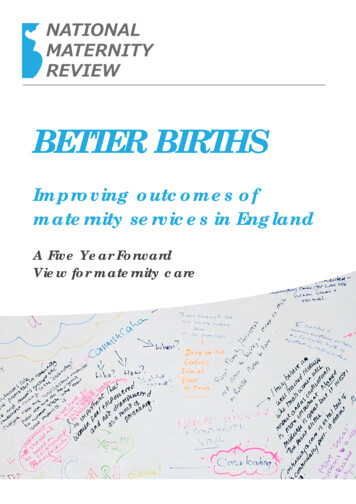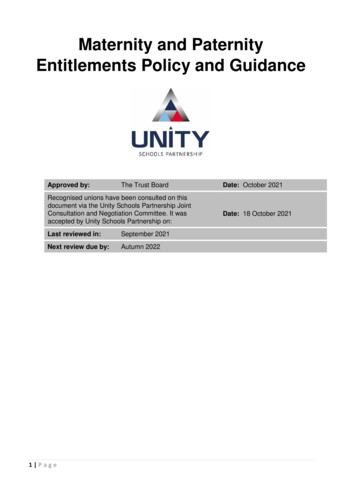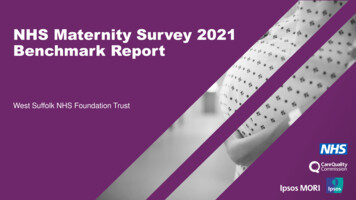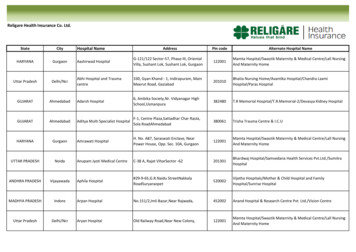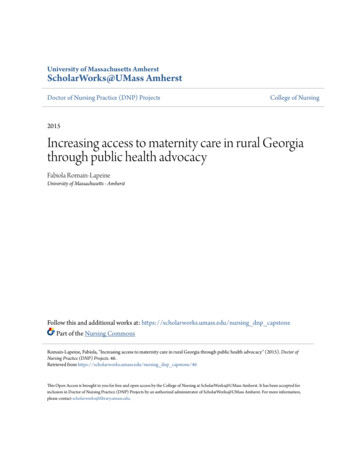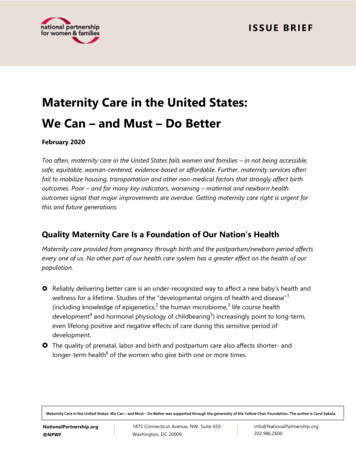
Transcription
ISSUE BRIEFMaternity Care in the United States:We Can – and Must – Do BetterFebruary 2020Too often, maternity care in the United States fails women and families – in not being accessible,safe, equitable, woman-centered, evidence-based or affordable. Further, maternity services oftenfail to mobilize housing, transportation and other non-medical factors that strongly affect birthoutcomes. Poor – and for many key indicators, worsening – maternal and newborn healthoutcomes signal that major improvements are overdue. Getting maternity care right is urgent forthis and future generations.Quality Maternity Care Is a Foundation of Our Nation’s HealthMaternity care provided from pregnancy through birth and the postpartum/newborn period affectsevery one of us. No other part of our health care system has a greater effect on the health of ourpopulation. Reliably delivering better care is an under-recognized way to affect a new baby’s health andwellness for a lifetime. Studies of the “developmental origins of health and disease”1(including knowledge of epigenetics,2 the human microbiome,3 life course healthdevelopment4 and hormonal physiology of childbearing5) increasingly point to long-term,even lifelong positive and negative effects of care during this sensitive period ofdevelopment. The quality of prenatal, labor and birth and postpartum care also affects shorter- andlonger-term health6 of the women who give birth one or more times.Maternity Care in the United States: We Can – and Must – Do Better was supported through the generosity of the Yellow Chair Foundation. The author is Carol Sakala.NationalPartnership.org1875 Connecticut Avenue, NW, Suite 650@NPWFWashington, DC 20009info@NationalPartnership.org202.986.2600
Maternity Care Is a Major Segment of the Health Care SystemMaternity care is also a major segment of the health care system. A baby is born every eightseconds in the United States.7 Within hospital-based care, maternal and newborn care towers overother conditions. More hospital stays are for pregnancy, childbirth and newborn care – 23% – than anyother reason by far.8Leading Reasons for Hospital Stay, United States,2014Percentage of All Inpatient SepticemiaOsteoarthritisCongestiveheart failurePneumonia Mood disordersCardiacdysrhythmias(Source: 10) Six of the 16 most common hospital procedures are for maternal or newborn care,including the nation’s most common operating room procedure: cesarean birth.9 Maternal and newborn care makes up 22.9% of all hospital charges billed toMedicaid, a medical assistance program for people with low incomes, and 15.0% of allhospital charges billed to private insurers.10NATIONAL PARTNERSHIP FOR WOMEN & FAMILIES ISSUE BRIEF Maternity Care in the United States2
Hospital Charges for Maternal and Newborn Care by Payer, UnitedStates, 2016Maternal and Newborn CareAll Other15%23%77%Medicaid85%Private Insurance(Source: 11)Many Women Struggle to Access Maternity CareWomen in the U.S. face financial, geographic, and other barriers to accessing maternity care. Thesechallenges especially affect those already vulnerable to poorer outcomes. Medicaid covers 42.3% of births, and private insurance covers 49.6%.11 For manywomen, the childbearing year involves changes in health insurance coverage (called“churn”),12 including becoming eligible for and then losing Medicaid coverage. The loss of access to contraceptive care and abortion services, including restrictionson access to Planned Parenthood clinics, which also provide prenatal andpostpartum care, harms women and newborns.13 Just 67.1% of pregnancies areintended.14 35% of counties are “maternity care deserts” with neither a hospital maternity unitnor any obstetrician-gynecologist or certified nurse-midwife.15 Most rural womenhave to drive more than a half hour to the nearest hospital with maternity services. 16 Almost one woman in five is unable to have her first prenatal visit as soon as shewants it. Women cite financial, insurance, and other reasons for this undesirabledelay.17 About 10% of women have no postpartum visit, and many with postpartum carereport that contraception, depression and other core topics are not discussed.18NATIONAL PARTNERSHIP FOR WOMEN & FAMILIES ISSUE BRIEF Maternity Care in the United States3
While women frequently experience new health concerns after giving birth,19 andabout 12% of pregnancy-related deaths occur from seven weeks to one year afterbirth,20 loss of or changes in health insurance after birth often makes seeking careand treatment difficult.21 Limited or no access to paid maternity leave burdens and constrains many families inthe postpartum period.22 Political turbulence in the health care environment (e.g., threats to Affordable CareAct and attempts to weaken Medicaid coverage) imperils many women’s access topublic and private insurance coverage and creates uncertainty for their serviceproviders.Too Often, Maternity Care Does Not Align With Quality or ChoiceDelivering the right maternity care is a challenge in the U.S.: patterns of overuse and underuse arecommon.23 Overuse is use of procedures, drugs or tests that offer no clear benefit and possibleharm – often in healthy women. Underuse is when safe, beneficial practices are not routinelyavailable. Every woman should have access to evidence-based maternity care and experienceshared decision making and support for her informed choices, a sequence that often does notoccur. About four in 10 women experience labor induction,24 yet research does not supportmany indications used for inducing labor.25 A pattern of many fewer births on weekends (and at night and on holidays) showsthe extent of scheduled births, and suggests that they are often timed for hospitaland workforce convenience versus interests of women and babies.26 A steep increase in the cesarean rate (now at 31.9% of all births27) over the last twodecades was not accompanied by any improved health outcomes for women orbabies; instead, many have been needlessly exposed to the additional short- andlong-term risks and complications of cesarean, compared with vaginal birth.28 A low-risk, first-time mom is up to 15 times more likely to have a cesarean birth atone hospital than another, and rates of vaginal birth after cesarean vary nearlytenfold by hospital.29 Hospital culture and care management factors, rather than thehealth needs of women or babies, are responsible for much variation in practice andmany cesarean births.30NATIONAL PARTNERSHIP FOR WOMEN & FAMILIES ISSUE BRIEF Maternity Care in the United States4
Almost half of women who are interested in having a vaginal birth after cesarean(VBAC) are denied that option, despite evidence and guidelines that support offeringVBAC to nearly all women with one or two past cesareans.31 This lack of access toevidence-based care contributes to a very high 86.7% repeat cesarean rate.32Mode of Birth, United States, 3.3All Womenvaginal birthWomen with Previous Cesareancesarean birth(Source: 12) Often, patterns of care fail to harness the benefits of innate healthy physiologicprocesses of women and their fetuses/newborns around the time of birth.33 Mostwomen now value avoiding unneeded maternity interventions; their interest inmidwives, birth centers and other forms of care that support these capabilities andlimit unneeded intervention far exceeds current use.34 The many effective care practices that are not widely provided include smokingcessation interventions in pregnancy, hand maneuvers to turn a fetus to a headfirstposition at term, planned labor after one or two cesareans, continuous supportduring labor, intermittent auscultation for fetal monitoring, being upright and mobileduring labor, and treating perinatal depression.35There are major concerns with the quality of care provided in the nation’s neonatal intensive careunits (NICUs).NATIONAL PARTNERSHIP FOR WOMEN & FAMILIES ISSUE BRIEF Maternity Care in the United States5
Care varies considerably across NICUs: most variation is unrelated to needs ofnewborns and preferences of families and thus is “unwarranted.” Another nonmedical factor shaping NICU care is supply-sensitive admission of lower and lowerrisk newborns due to a nearly 70% increase in the number of NICU beds pernewborn and large growth in the number of neonatologists from 1995 to 2013.36 Due to these factors, many newborns get too much care and pay the price ofunneeded separation from mothers and harmful exposures with little or no benefit,while others get too little care or the wrong care.37Maternity Care Outcomes Are Unacceptable, and Many Are WorseningTrends are going in the wrong direction for a series of consequential outcomes in women andbabies. Pregnancy-related deaths rose from 7.2 per 100,000 live births in 1987 to 16.9 per100,000 in 2016.38 A portion of this rise is due to efforts to improve measurementand better measurement.39 The distribution of pregnancy-related deaths clarifies that improvements are neededacross the continuum of care: about one-third occur during pregnancy, one-third onthe day of birth through first week, and one-third from day 7 through the first yearpostpartum.40 Severe maternal morbidity (21 conditions and procedures signaling a “near miss” ofdying) rose 45% from 2006 through 2015, from 101.3 to 146.6 per 10,000hospitalizations for birth.41 Preterm birth (before 37 weeks of pregnancy) rose from 9.57% in 2014 to 10.02% in2018.42 Low birthweight (less than 5.5 pounds) rose from 8.00% in 2014 to 8.28% in 2018.43Many women face less dire yet distressing and debilitating pregnancy experiences and birthoutcomes. Despite broad recognition that the steep rise in the cesarean rate since the mid1990s involved no discernible gains in maternal or infant health,44 that thisprocedure poses many excess risks for women and cesarean-born babies,45 and thattoo many women give birth by cesarean,46 the nation’s cesarean rate has essentiallyplateaued for a decade at nearly one in three.47NATIONAL PARTNERSHIP FOR WOMEN & FAMILIES ISSUE BRIEF Maternity Care in the United States6
In the postpartum period, women experience a broad array of new-onset morbidities– including pain, exhaustion and infections – and in many instances these persist tosix or more months after birth.48 Anxiety and depression are prevalent during both pregnancy and the postpartumperiod, and the great majority who screen positive for these conditions do notreceive treatment.49Breastfeeding, which offers multiple shorter- and longer-term preventive benefits to both women50and babies,51 falls far short of recommendations. Just 26.1% of babies are born in “Baby-Friendly” facilities with demonstratedprovision of supportive breastfeeding practices.52 Just 24.9% of babies are exclusively breastfed through six months, the standard thatprofessional societies recommend.53 Considerably more women intend to meet thisgoal, but unsupportive health care practices and social and workplace policies ofteninterfere.54 Professional societies also recommend continued breastfeeding to one year orbeyond, yet just 35.9% are breastfeeding at 12 months.55Substance use disorders affect many childbearing women and their babies. In 2016, 91,800 births – or 24.3 per 1,000 hospital stays for birth – had a substanceuse disorder (SUD) diagnosis involving opioids, cocaine and other stimulants.56 Compared with births without this diagnosis, those with SUD were more likely toexperience a series of consequential adverse clinical outcomes.57On Key Maternal and Infant Indicators, the United States ComparesVery Unfavorably to Most-Similar NationsDespite the nation’s affluence and outsized expenditure for maternal-newborn care (see below),many other nations achieve superior results for key perinatal indicators. Compared with 10 other high-income nations (Australia, Canada, Denmark, France,Germany, Japan, the Netherlands, Sweden, Switzerland, United Kingdom), the U.S.has the highest: maternal mortality (26.4/100,000 live births, versus mean 8.4 forthese nations), neonatal mortality (4/1,000 live births, mean 2.6), infant mortality5.8/1,000 live (births, mean 3.6) and cesarean rate (33% of live births, mean 25%),and second highest low birth weight rate (8.1% of live births, mean 6.6%).58NATIONAL PARTNERSHIP FOR WOMEN & FAMILIES ISSUE BRIEF Maternity Care in the United States7
The United States ranks 33rd among world nations on Save the Children’s MothersIndex, a composite of maternal health, child wellbeing, education, economic securityand political participation.59Outcomes of Maternity Care Are InequitableRacial and ethnic disparities are often extreme and especially impact Black and Native women andnewborns. Rural and low-income women also face disproportionately adverse maternal-infantoutcomes. Black women are more than three times as likely and Native women more than twiceas likely as white women to experience pregnancy-related death.60 60% of pregnancy-related deaths are considered preventable, including by access toand provision of quality care, with no difference in preventability by Black or Hispanicversus white women.61Pregnancy-Related Mortality* byRace/Ethnicity, United States, 2011-201340.829.513.5BlackAmerican Indian Asian and Pacificand AlaskaIslanderNative12.711.5WhiteHispanic* Deaths per 100,000 live births during or within one year of pregnancy,(Source: 59) Black women, Hispanic women and women of other races/ethnicitiesdisproportionately experience births with severe maternal morbidity (66%, 10% and15% higher, respectively), relative to white women. SMM is associated with a highrate of preventability.62NATIONAL PARTNERSHIP FOR WOMEN & FAMILIES ISSUE BRIEF Maternity Care in the United States8
Rural women are 9% more likely than urban women to experience a compositemeasure of severe maternal morbidity and maternal mortality,63 and 59% more likelyto have a substance use disorder diagnosis at the time of birth.64 Infant, neonatal and post-neonatal mortality rates are higher in rural than urbancounties.65 Babies born in the Delta Regional Authority (252 counties in AL, AR, IL, KY, LA, MO,MS, TN) and the Appalachian Regional Commission (420 counties in AL, GA, KY, MD,MS, NY, NC, OH, PA, SC, TN, VA, WV) are more likely than babies born in the rest ofthe nation to experience preterm birth, low birth weight and infant mortality,reflecting geographic variation in levels of economic distress and disadvantage66 andracism.67 Rates of teen birth vary fourfold across states, from 7.2 per 1,000 births inMassachusetts to 30.4 per 1,000 births in Arkansas.68 Infant mortality and neonatal mortality reflect a two- to three-fold gradient similar tothe above pregnancy-related mortality chart, ranging from highest rates amonginfants of Black women to lowest rates among infants of Asian women.69 Other practices and outcomes that vary by race and ethnicity include rate of births toteens aged 15 through 19, proportion initiating prenatal care in the first trimester,rate of smoking during pregnancy, rates of labor induction and cesarean birth, ratesof preterm birth and low birth weight, and rates of breastfeeding initiation andduration.70Maternity Care is Very Costly, and Resources Are Poorly Aligned WithNeedHigh-value maternity care means good birth outcomes paired with wise spending. On top ofunacceptable outcomes, the cost of maternity care in the U.S. is very high and rising.71 Outdatedpayment systems (paying for doing things regardless of whether good care was provided and goodoutcomes attained), patterns of intensive procedure use and high prices contribute to care that isunnecessarily and unsustainably expensive. The nation’s overall health care costs exceed those of other nations by far, whethermeasured as proportion of gross domestic product or average cost per person.72 Inavailable international comparisons of maternity care costs, those in the UnitedStates are regularly the highest.73NATIONAL PARTNERSHIP FOR WOMEN & FAMILIES ISSUE BRIEF Maternity Care in the United States9
Together, maternal and newborn care are the most expensive hospital conditions forMedicaid, private insurance and all payers.74 The average actual price paid for hospital fees alone was 11,200 for a vaginal birthand 15,000 for a cesarean birth when covered by private insurers in 2017.75 Thisfigure does not include provider fees; services such as anesthesiology or pharmacy;nor any prenatal or postpartum care. Historically, actual prices paid for all maternal and newborn care are about 50%higher when the birth is cesarean rather than vaginal.76 Costs of a primary, or first,cesarean compound over time with the high rate of routine repeat cesarean.77 Historically, actual prices that Medicaid pays to service providers for all maternal andnewborn care are about half the amount of private payments, despite the frequentlygreater health needs of women covered by Medicaid.78 (Even Medicaid payments areon the high end of the international range.)79 About four in five of all dollars paid on behalf of maternal and newborn care go tothe facility and other payments for the relatively brief hospital phase of care. 80 Highrates of costly procedures (e.g., induced labor, epidural analgesia, cesarean birth) inthis largely young and healthy population contribute to the expense of hospital birth. Highly profitable newborn intensive care units (NICUs) also contribute to in-hospitalresource use. A steep growth in the number of NICUs and number of neonatologistshas been associated with supply-induced demand and admission of healthier andhealthier newborns to NICUs,81 in addition to sicker babies who are likely to benefitfrom such care. Limited resources allocated to prenatal and postpartum care (just one in five of alldollars paid for maternal and newborn care82) limit the care team’s ability to addressindividual needs at a time when women are engaged, motivated and have extendedcontact with the health care system. Lack of resources for linking to needed socialand community services and coordinating care across the clinical episode is deeplytroubling.NATIONAL PARTNERSHIP FOR WOMEN & FAMILIES ISSUE BRIEF Maternity Care in the United States10
Total Maternal-Newborn Payments by Phase ofCare, United States, 2010 25,0001.4% 20,000 15,00082.9%3.8% 10,00071.6% 5,00015.6%24.5%Private InsurersMedicaid 0Prenatal CareIntrapartum and Newborn CarePostpartum Care(Source: 79) Considering just low-risk births, cost varies widely,83 and hospital factors but notquality are associated with higher costs.84 Out-of-pocket costs of childbearing families with commercial insurance can beespecially high85 due to their contribution to premiums, deductibles (possiblyincurred twice across two plan-years), co-pays, co-insurance, unexpected hefty outof-network charges (e.g., for anesthesiologist) and uncovered costs (e.g., for labordoula). This comes at a time when families incur increased non-health expenses andmany lack paid family and medical leave.Sustained Stakeholder Commitment Can Transform Maternity CareThe shortcomings of the U.S. maternity care system provide extensive opportunities forimprovement, and many stakeholders are taking up the challenge. Recent, promising signs ofmomentum in the right direction include: Growing recognition that inequity and harmful “social determinants of health” suchas systemic racism; lack of access to paid family and medical leave; and inadequatehousing, transportation and economic security shape birth outcomes and must beaddressed to achieve optimal health outcomes.NATIONAL PARTNERSHIP FOR WOMEN & FAMILIES ISSUE BRIEF Maternity Care in the United States11
Efforts to provide ready access to maternity care for all women, including throughuniversal coverage extending to one year postpartum and by reversing the loss ofmaternity services in rural areas Practice recommendations that support provision of beneficial, underused carepractices while avoiding unneeded, harmful ones Episode, maternity care home and other alternative payment models that incentivizehigh-quality care, increasingly used by Medicaid and other payers Increasing use of high-value maternity care models, including midwifery-led care,birth center care, team-based care, doula support, and culturally concordant servicesof community-based perinatal health workers Quality measurement that can inform all stakeholders about opportunities forimprovement and increase accountability, along with quality improvement initiativessuch as perinatal quality collaboratives and Council on Patient Safety in Women’sHealth Care maternal safety bundles Decision aids and other toolsto help women obtain safe, effective care aligned withtheir individual needs and preferencesThese positive changes are just the beginning of the transformation that can and must occur. Untilwe reliably pay for the right care, change the culture of practice and scope of care and avoid thewaste of less effective and all-too-often harmful care, families and payers will be vulnerable tounacceptable outcomes and excessive costs. Policymakers, clinical leaders, advocates and otherstakeholders must commit to long-term, far-reaching efforts to create a uniformly high-quality,high-value maternity care system that is equitable for all women and families.1Kermack, A., Van Rijn, B., Houghton, F., Calder, P., Cameron, I., & Macklon, N. (2015). The ‘developmental origins’hypothesis: Relevance to the obstetrician and gynecologist. Journal of Developmental Origins of Health andDisease, 6(5), 415-424. Retrieved 24 December 2019, from n, M. A. & Gluckman, P. D. (2014, October) Early developmental conditioning of later health and disease:Physiology or pathophysiology? Physiological Reviews 94, 1027–1076. Retrieved 24 December 2019, ysrev.00029.20132Dahlen, H. G., Kennedy, H. P., Anderson, C. M., Bell, A. F., Clark, A., Foureur, M., Downe, S. (2013). The EPIIChypothesis: Intrapartum effects on the neonatal epigenome and consequent health outcomes. MedicalHypotheses, 80(5), 656–662. Retrieved 24 December 2019, fromhttps://www.ncbi.nlm.nih.gov/pubmed/23414680; Dahlen, H. G., Downe, S., Kennedy, H. P., Foureur, M. (2014,December). Is society being reshaped on a microbiological and epigenetic level by the way women give birth?Midwifery, 30(12), 1149–1151. Retrieved 24 December 2019, ueller, N. T., Bakacs, E., Combellick, J., Grigoryan, Z., Dominguez-Bello, M. G. (2015). The infant microbiomedevelopment: Mom matters. Trends in molecular medicine, 21(2), 109–117. Retrieved 24 December 2019, fromhttps://www.ncbi.nlm.nih.gov/pubmed/25578246; Penders, J., Thijs, C., Vink, C., Stelma, F. F., Snijders, B.,Kummeling, I., Stobberingh, E. E. (2006, August). Factors influencing the composition of the intestinal microbiota inNATIONAL PARTNERSHIP FOR WOMEN & FAMILIES ISSUE BRIEF Maternity Care in the United States12
early infancy. Pediatrics, 118 (2), 511-521. Retrieved 24 December 2014 alfon, N., Larson, K., Lu, M., Tullis, E., & Russ, S. (2014). Lifecourse health development: past, present and future.Maternal and Child Health Journal, 18(2), 344–365. Retrieved 24 December 2019, uckley, S. J. (2015, January). Hormonal Physiology of Childbearing: Evidence and Implications for Women, Babies,and Maternity Care. Retrieved 24 December 2019, from National Partnership for Women & Families hildbearing.pdf;Sakala, C., Romano, A. M., Buckley, S. J. (2016). Hormonal physiology of childbearing, an essential framework formaternal–newborn nursing. Journal of Obstetric, Gynecologic & Neonatal Nursing, 45(2), 264 – 275. Retrieved 24December 2019, from n, B., Baschat, A. A. (2017, April). Pregnancy: An underutilized window of opportunity to improve long-termmaternal and infant health-an appeal for continuous family care and interdisciplinary communication. Frontiers inPediatrics, 5, 69. Retrieved 24 December 2019, from https://www.ncbi.nlm.nih.gov/pubmed/28451583; Neiger, R.(2017). Long-term effects of pregnancy complications on maternal health: A review. Journal of Clinical Medicine,6(8), 76. Retrieved 24 December 2019, from https://www.ncbi.nlm.nih.gov/pubmed/28749442; Gregory, K. D,Jackson, S., Korst, L., Fridman, M. (2012, January). Cesarean versus vaginal delivery: Whose risks? Whose benefits?American Journal of Perinatology, 29(1):7-18. Retrieved 24 December 2019, fromhttps://www.ncbi.nlm.nih.gov/pubmed/21833896; Bartick, M. C., Schwarz, E. B., Green, B. D., Jegier, B. J.,Reinhold, A. G., Colaizy, T. T., Stuebe, A. M. (2016, September). Suboptimal breastfeeding in the United States:Maternal and pediatric health outcomes and costs. Maternal & Child Nutrition, 13(1). Retrieved 26 May 2019, fromhttps://www.ncbi.nlm.nih.gov/pubmed/27647492; Glynn, L. M., Howland, M. A., & Fox, M. (2018, August).Maternal programming: Application of a developmental psychopathology perspective. Development andPsychopathology, 30(3), 905–919. Retrieved 28 December 2019, 274636/;7Hamilton, B. E., Martin, J. A., Osterman, M. J. K., M.H.S., Driscoll, A. K., Rossen, L. M. (2017, June). Births:Provisional Data for 2016. Retrieved 26 May 2019, from Centers for Disease Control and Prevention, NationalCenter for Health Statistics, Division of Vital Statistics website: 016 data)8McDermott, K. W., Elixhauser, A, Sun, R. (2017, June). Trends in Hospital Inpatient Stays in the United States,2005–2014. Retrieved 26 May 2019, from U.S. Department of Health and Human Services, Agency for Health CareResearch and Quality, Healthcare Cost and Utilization Project riefs/sb225-Inpatient-US-Stays-Trends.pdf (2014 data)9U.S. Department of Health and Human Services, Agency for Health Care Research and Quality, Healthcare Costand Utilization Project. (n.d.). Retrieved 28 December 2019, from https://hcupnet.ahrq.gov/#setup (2015 data)10U.S. Department of Health and Human Services, Agency for Health Care Research and Quality, Healthcare Costand Utilization Project. (n.d.). Retrieved 28 December 2019, from https://hcupnet.ahrq.gov/#setup (2016 data)11Martin, J. A., Hamilton, B. E., Osterman, M. J. K., & Driscoll, A. K. (2019, November). Births: Final Data for 2018.Retrieved 28 December 2019, from Centers for Disease Control and Prevention, National Center for HealthStatistics, Division of Vital Statistics website: https://www.cdc.gov/nchs/data/nvsr/nvsr68/nvsr68 13-508.pdf(2018 data. (Another 4.2% are uninsured, while 3.9% are covered by other sources, including other governmentalsources.)12Daw, J. R., Hatfiel, L. A., Swartz, K., Sommers, B. D. (2017, April). Women in the United States experience highrates of coverage 'churn' in months before and after childbirth. Health Affairs, 36(4):598-606. Retrieved 26 May2019, from ware, D. R. (2017). Recent increases in the U.S. maternal mortality rate: Disentangling trends frommeasurement issues. Obstetrics & Gynecology, 129(2), 385-386.;Association of State and Territorial Health Officials. (December 2019). Access to reproductive health servicesposition statement. Retrieved 26 November, 2019 from tements/Reproductive-Health-Services/;NATIONAL PARTNERSHIP FOR WOMEN & FAMILIES ISSUE BRIEF Maternity Care in the United States13
Quinn, M. (May 2017). Why Texas is the most dangerous U.S. state to have a baby. Governing the States andLocalities. Governing. Retrieved May 26, 2019 from exas.html;National Partnership for Women & Families. (2019, October). Maternal Health and Abortion Restrictions: How Lackof Access to Quality Care Is Harming Black Women. Retrieved 1 November 2019, enters for Disease Control and Prevention, National Center for Health Statistics, National Survey of FamilyGrowth. (2017, June). Key Statistics from the National Survey of Family Growth - I Listing. Retrieved 28 December2019 from https://www.cdc.gov/nchs/nsfg/key statistics/i.htm#intended (2011-2015 data)15March of Dimes. (2018). Nowhere to Go: Maternity Care Deserts Across the U.S. Retrieved 26 May 2019, fromhttps://www.marchofdimes.org/materials/Nowhere to Go Final.pdf (2016 data)16American College of Obstetricians and Gynecologists. (2014, February). Committee Opinion No. 586: Healthdisparities in rural women. Obstetrics & Gynecology, 123(2 pt. 1), 384–8.Retrieved 26 May 2019, 17Declercq E. R., Sakala, C., Corry M. P., Applebaum, S., Herrlich, A. (2013, May).Listening to Mothers III: Pregnancy and Birth. Retrieved 26 May 2019 from National Partnership for Women &Families website: -pregnancy-and-birth-2013.pdf (2011-2012 data)18See note 18; American College of Obstetricians and Gynecologists. (2018, May). Optimizing postpartum care.ACOG Committee Opinion No. 736: Optimizing postpartum care. Obstetrics & Gynecology, 131, 140–150. Retrieved26 May 2019, from https
Too often, maternity care in the United States fails women and families - in not being accessible, safe, equitable, woman-centered, evidence-based or affordable. Further, maternity services often fail to mobilize housing, transportation and other non-medical factors that strongly affect birth outcomes.





